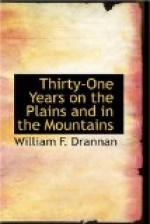At the first fire with our pistols three of the Indians fell, leaving four yet mounted and one on foot—the one whose horse I had shot at the first fire. I saw the Indian on foot making for some sage brush near by and sang out to a man named Saunders, who was on a fine grey horse, to run that Indian down, which he did, killing him the second shot, so he said afterwards.
About this time I saw Jim coming, with six or eight men following him closely. Then we all commenced yelling at the top of our voices, which excited the Indians still more. Whether they saw our men coming or not I do not know, but two of them ran almost right up to them and were shot down at a distance of thirty or forty yards.
We succeeded in getting the other two, not letting one escape to tell the tale; thereby accomplishing just what I started to do when I first got sight of them.
After the last Indian had fallen, I rode to where Jim was and told him of the big band of Indians I had seen that day, and suggested that we had better go to Barrel Springs that night, which was about four miles further on, as I thought that the best place to be in camp in case we were attacked by the Indians. In this he agreed with me.
By this time my men were all on the battle-field, and most of the men from the train, also a number of the women who had come out to see the dead Indians. I asked one of the boys to go with me to scalp the Indians, after which I would go to the train as I wanted to change horses, but none of them knew how to scalp an Indian, so Jim and I had to teach them how.
One old man, who was looking on, said: “I would not mind shooting an Indian, but I would not like to scalp one of them.”
After scalping the nine Indians we rode to the train and showed the scalps to the women. One young lady said to me:
“I always took you to be a gentleman until now.”
I said: “Miss, I claim to be only a plain plains gentleman, but that at any and all times.”
She said: “I don’t think a gentleman could be so barbarous as you are.”
“My dear lady,” I replied, “the taking of these scalps may be the means of saving the train,” and then I explained why we always scalped the Indians when we killed them. I told her that the Indians did not fear death, but hated the idea of being scalped.
About this time Jim Bridger came up and gave a more through explanation of the scalping business, and I did not hear anything more of it at that time. But Jim often teased the young lady spoken of, who had a lovely head of hair, by remarking what a fine scalp it would make for the Indians.
I changed saddle horses and then myself and two assistants rode out north to watch the movements of the main band of Indians.
Before starting out Jim gave us the password of the pickets, which was “Buffalo.”
We rode until near sunset before we got sight of the big band of Indians again, they having gone into camp about four miles west of Barrel Springs, where our train was camped, and only about a half mile from the trail or wagon road.




